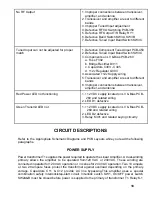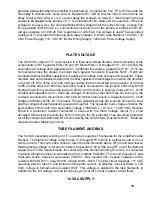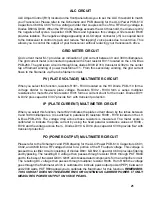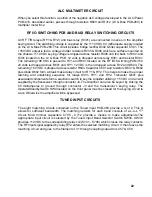
11
approximately 100 watts of RF output. You can use a transceiver that has lower output power, but
the Amplifier's output will be less. If you use a transceiver that delivers more than 100 watts,
carefully adjust the driving power to avoid "overdrive" and the creation of spurious signals, which
create needless interference to other operators.
IMPORTANT:
In no case should you advance
the power output control of your transceiver beyond the point where the Amplifier's power output
indication ceases to increase. If you turn the control past this point , nonlinear operation may
occur.
TUBE
It is not abnormal for the tube to show a dull red color. But if the plate shows a bright orange or
yellow color, immediately investigate the tuning and drive conditions and make any necessary
corrections. After prolonged operation, let the Amplifier run for several minutes without drive
applied so the fan will cool the tubes before you turn the Amplifier off.
READING THE METERS
R
efer to Front Panel Pictorial while you read the following information:
Multimeter:
The Multimeter switch on the front panel of the Amplifier selects the right-hand
meter functions. Read
the meter
scale which corresponds to the setting of the Multimeter
switch as shown in Table A.
Grid Meter:
The left-hand meter always indicates grid current between 0 and 300
milliamperes. Each Division indicates 10 milliamperes.
Table A
Multimeter Switch
Position
Measures
Scale Indication
Plate Voltage (PV)
Plate Voltage
Center scale indicates 0 to 3500 volts
(normal operating range is 2700 to 3200
volts) Each division represents 100 volts.
Plate Current (IP)
Plate Current
Top meter scale indicates 0 to 1400
milliamperes. Each division represents 40
milliamperes.
Power Output (PO)
PEP RF Power
Bottom meter scale indicates 0 to 2000
(PEP)
voice peak only
watts
. Does not
measure average or RMS power
ALC
ALC Detector
Indicates relative ALC Output
TUNE-UP PROCEDURE








































